Encounters with India's Splendid and Vast Cultural Heritage
India February and March 2014, with Tropical Ice
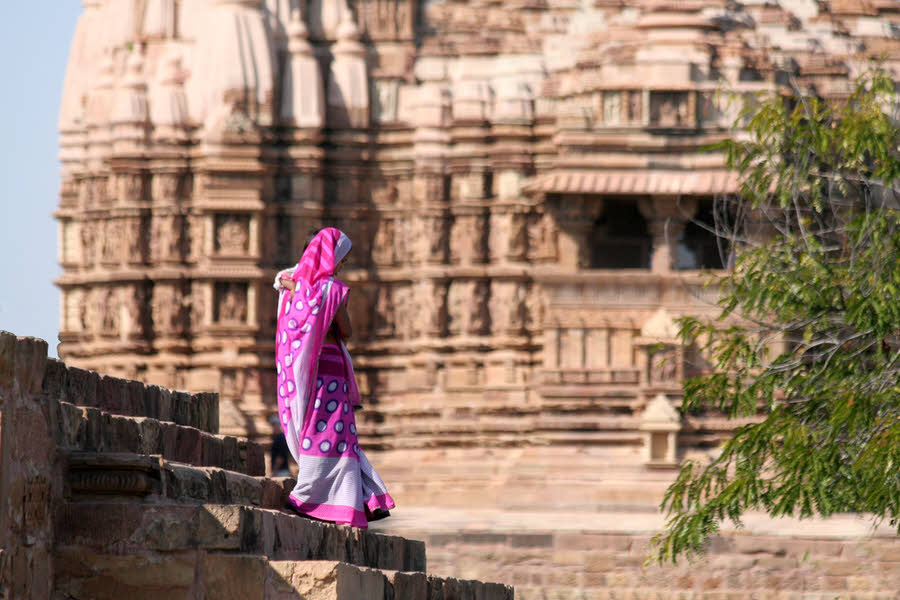
 Bookmark this on Delicious
Bookmark this on Delicious
 Recommend to StumbleUpon
Recommend to StumbleUpon

While the trip's prime goals were seeing tigers and walking, only fools could travel in India, and not avail themselves of some of the cultural heritage there.
This page will look at some of the culture we encountered, in the order we encountered it.
Call me nervous and self-indulgent, but when joining an organized tour, far from home, I like to arrive a day early. Then there's no problem if a flight is delayed, and also I start the tour "fresh". Of course, any sensible tour makes allowance for these issues. I like to build in a little "extra allowance".
So I arrived in Delhi a day early. Went to the splendid Imperial Hotel, on Janpath... where I spent my first night on my first trip to India. And was not disappointed. (The Imperial will eventually get further mention in a "where we stayed" page... but it is a bit of "culture" in its own right.)
I was greeted at the door with "Welcome home". In most places, I would bridle at such a "silly" welcome. However, the Imperial is in a league where it can use a greeting like that without seeming stupid.
Had a nice stroll in the neighborhood of the hotel in what was left of my first day. Stretched legs, and the rest of me. Got some "fresh air". Etc. Indulged in a first class meal, in the hotel, early night. (Lobster thermador for the first time in my life!... and very nice it was.)
"The trip", as organized by Tropical Ice, began in the bar of the Imperial the evening of the 23rd.
I spent much of the day visiting Humayun's tomb (-WP-) (That signifies a link to a Wikipedia page which will open in a new tab or window), and the National Museum, Delhi (-WP-).
The two made a very tidy "package", with a simple taxi ride getting me to the first, the inexpensive fares allowing me to ask the driver to wait 90 minutes, and then take me on to the National Museum. (Went maybe 5 miles, took up 2 hours of driver's time: R500... about $10... including tip.) From the museum, I could have walked back to the hotel, but took a tuk-tuk, for the fun of it.
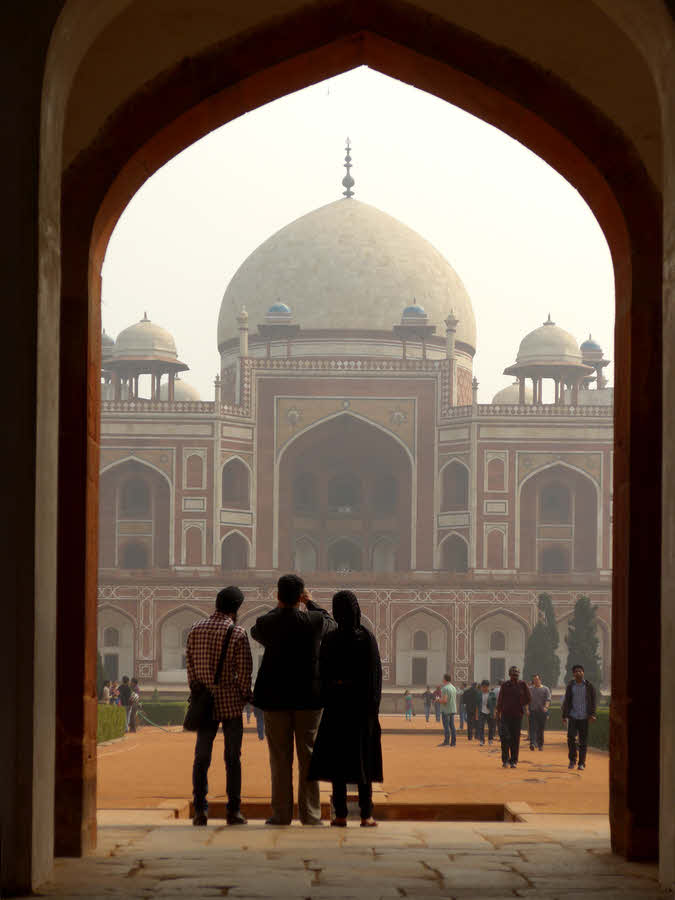
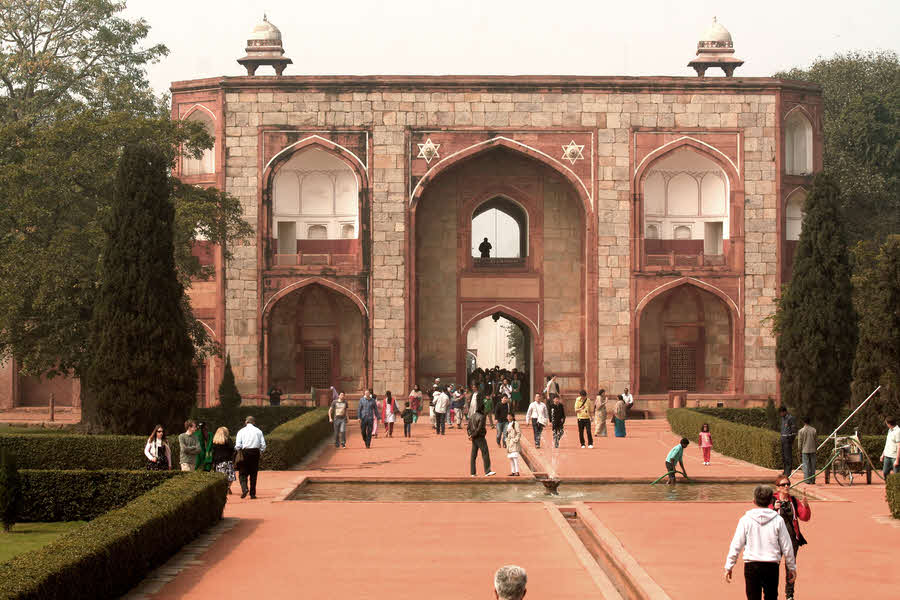
(One the right, above, the entrance into the central courtyard of the tomb complex, seen from the tomb.)
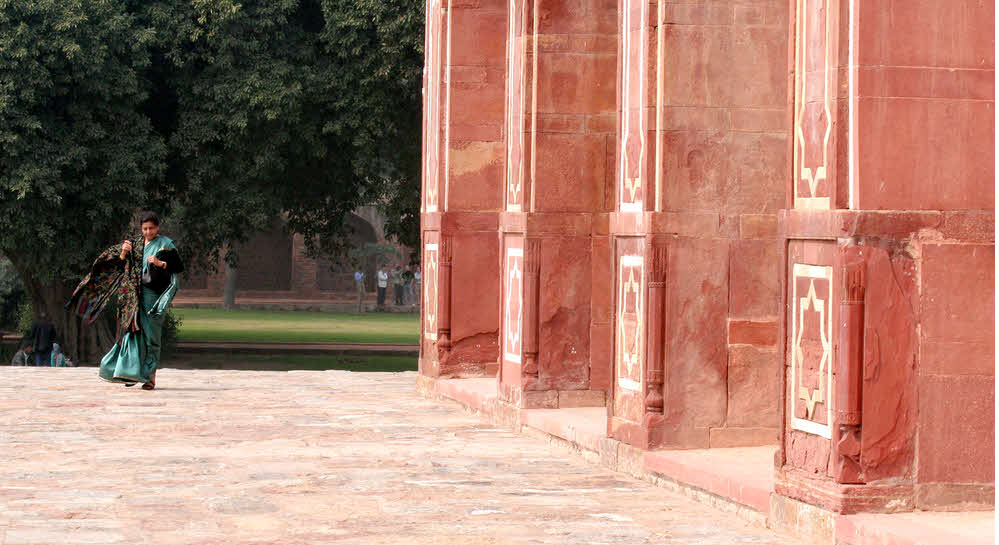
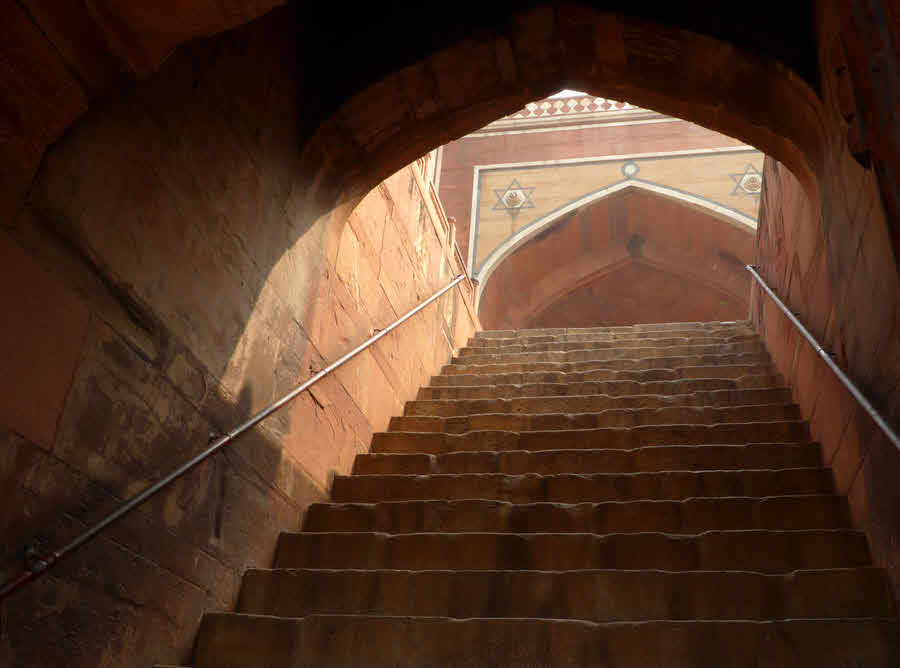
Humayun's tomb was well worth a visit... my first. Extensive renovation, funded in part by the Aha Khan, in recent years makes it more visit- worthy than it was back in 2007. Architecturally, and culturally: a pre-cursor of the incomparable Taj Mahal. I'd visited the national museum before... but it was well worth re-visiting.
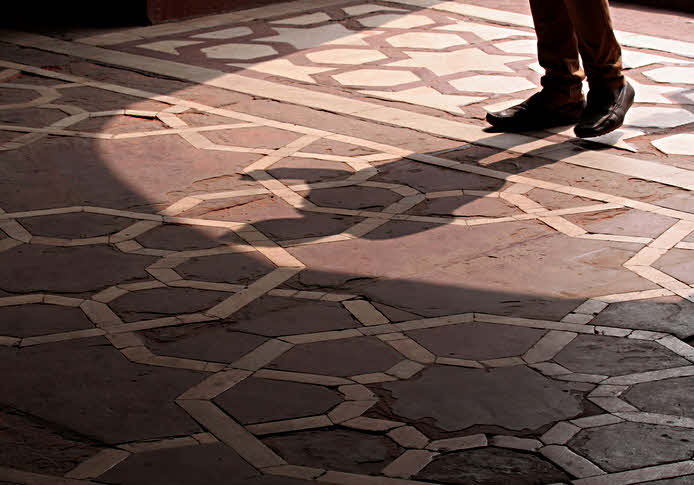
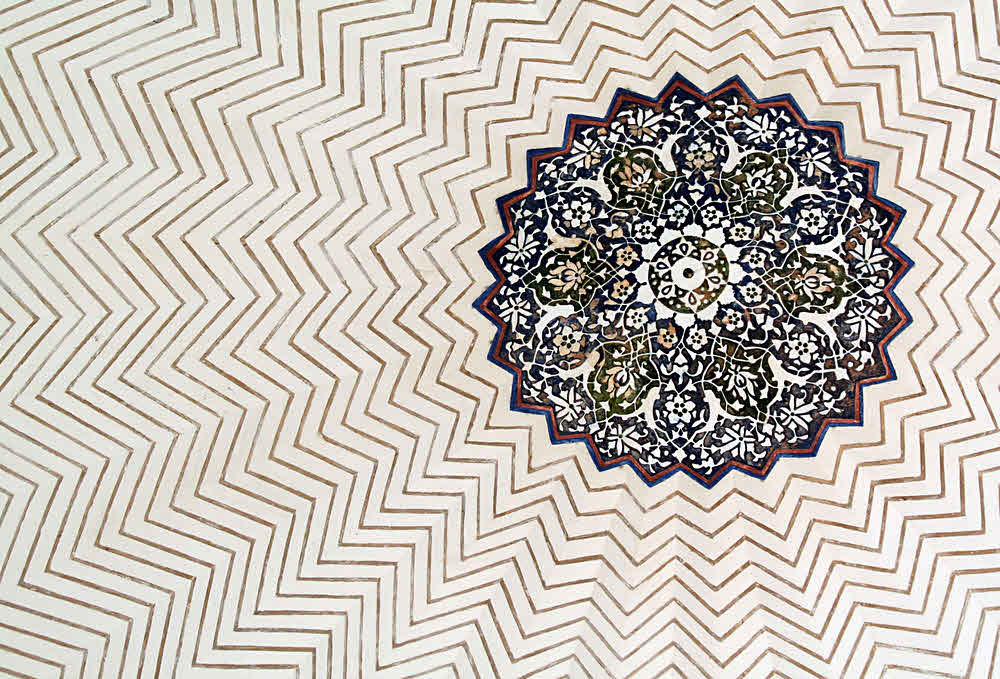
(Center of dome, inside tomb)
Later, I went off on A Mission: I had a number of photos from a friend's visit to India around the year 2000. So I has "then" photos... I was trying to capture "now" photos. Having asked a number of people, I eventually learned that one of the photos had been taken opposite the Red Fort, and so I went up to that end of town with time I had in the afternoon.
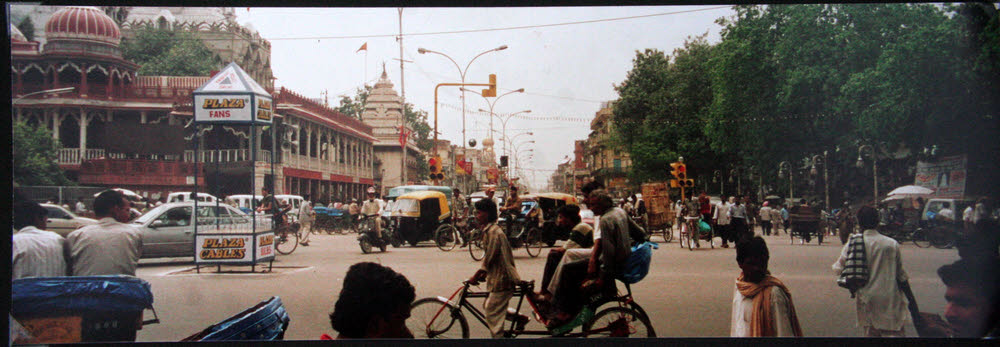
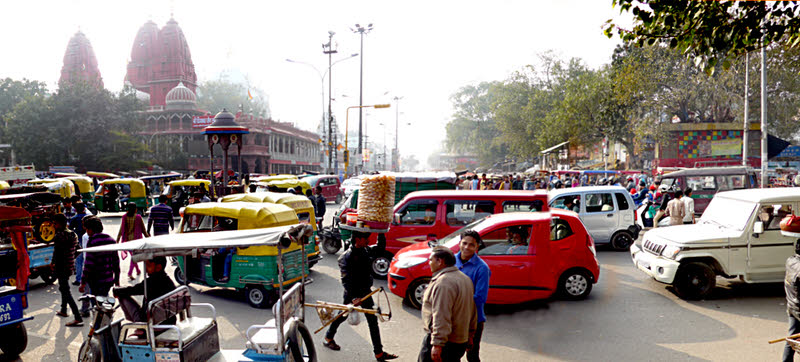
In Old Delhi, east of red fort, near big mosque. Jain temple in left of scene. Found the site by the simple expedient of showing the old photo to a number of people in the street until someone could say "Opposite the Red Fort".
If you knew the conditions I was working in, you might cut my poor result some slack: Impossible light, heavy traffic, fighting a need to head towards my hotel, an uncertain distance away across the city, and the first meeting of our group scheduled. AND I got groped by a beggar who didn't like my declining to give her any handout!
The little "gazebo" in the center of the intersection has been, you will see, upgraded. It is for a traffic policeman, though what he can do there is beyond me, and probably him.
The high domes were almost certainly present when the first picture was taken, just not in view.
Don't be too puzzled by the odd red car, just right of center.... it is an artifact of joining two photos.
When my friend took the left hand image, he didn't have quite as much traffic to contend with back then, nor the beggar, but here's his account of when he took his picture....
"At the time that I took the panoramic picture I had a small boy of about twelve or thirteen shouting at me "You are a Very Bad Man! I curse you! I curse your children! I curse your family! You are very very bad...."
"I had just refused to pay him 100 rupees for a cycle rickshaw journey of five minutes, a journey that would typically cost about 5 rupees.
"I think I had paid him about 20, and as a result of my 'stinginess' he kept up a loud tirade for about fifteen minutes, before the guards at the Red Fort sent him packing. Nobody else, including me, took any notice of him whatsoever."
I think many people who've visited India will smile at the familiarity of much of that, apart from the boy's unsusal loud aggressive rudeness.
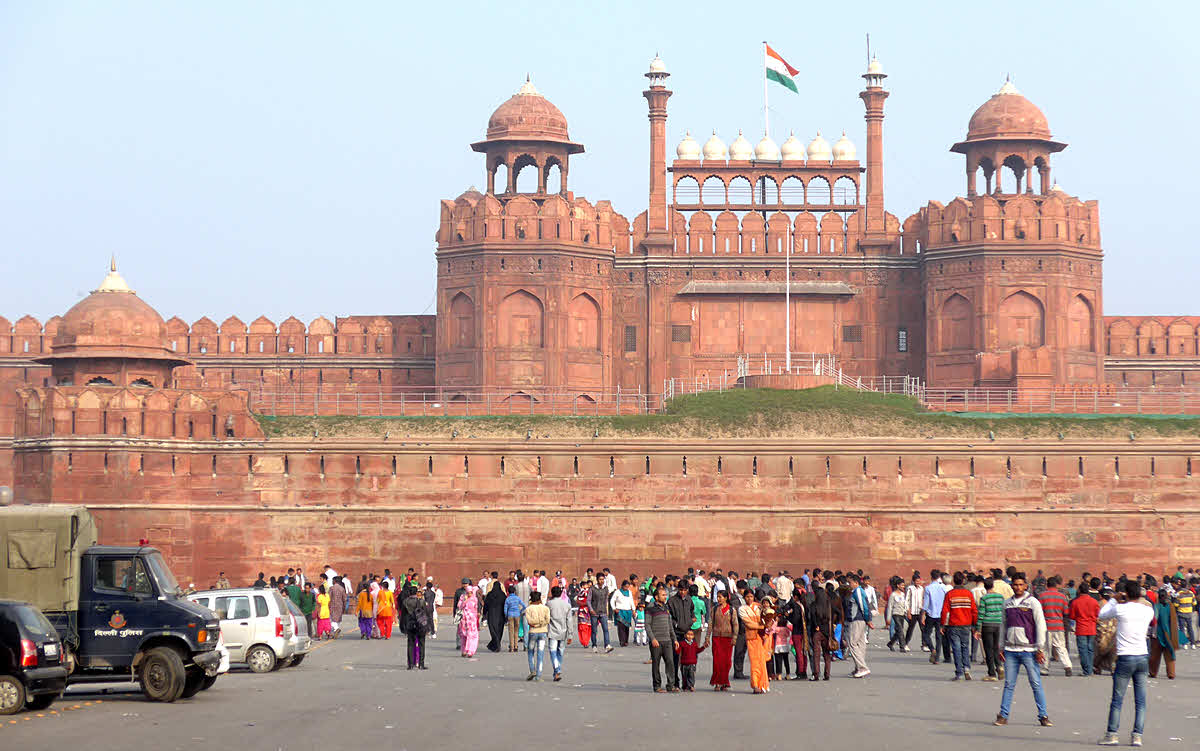
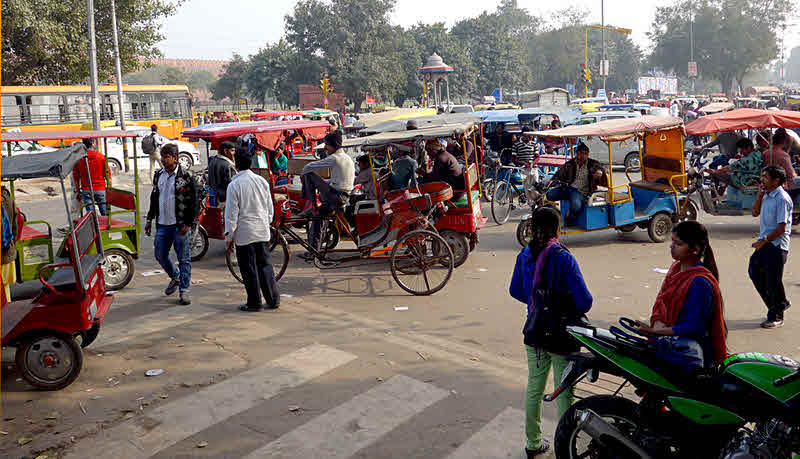
On the left above: what was behind me when I took the busy street scene above. Delhi's Red Fort. And on the right another indication of the traffic I was "in" while trying to get the shot. You can see the traffic policeman's gazebp again, and a hint of the red fort. From where the above picture was taken, you would walk clockwise about 120 degree around the gazebo to be where the photo towards Jain temple was taken.
And thus to the bar at the Imperial, for a convivial start to the "official" tour. Followed by dinner with M and A, who kindly shared a final meal with me at the other end of the tour, creating an agreeable symmetry. While all three of us liked Indian food, we knew we might see a lot of it in the days ahead, and the Imperial's Italian restaurant came highly recommended, so we dined there. Good choice! Ironically, due to more limited choices, our final meal was Italian, too!
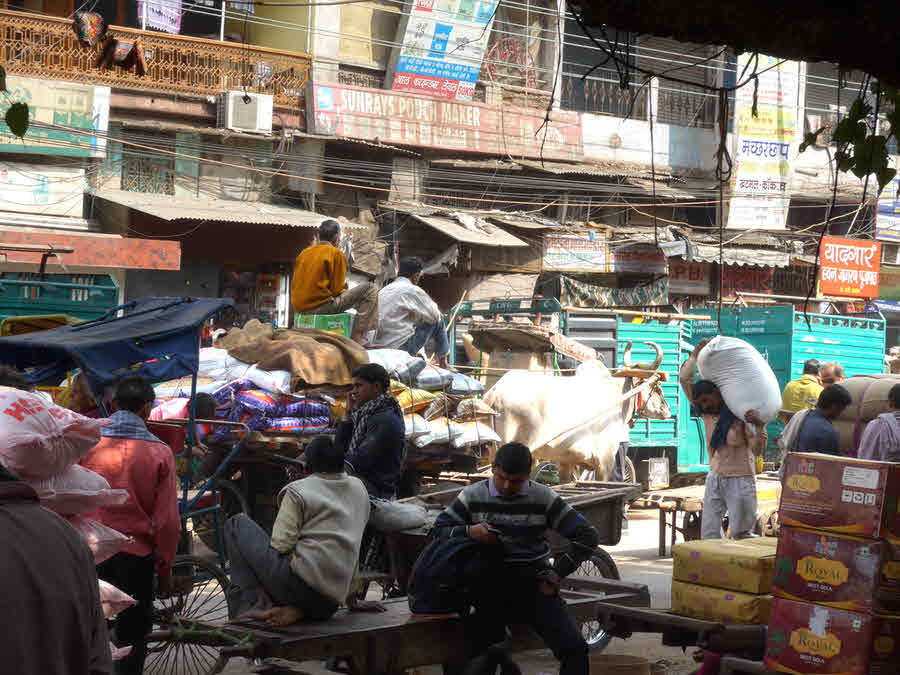
The day started with a good walking tour in the heart of Old Delhi, with an excellent guide. Among other things, we stepped off of the "lane" for a moment, into a quiet side compound, home, mostly, of one extended family, and visited the small associated Jain temple. A side of Delhi, and I suspect many such cities, that I'd not experienced before.
Then we visited the amazing Qutb Complex (-WP-), on the edge of Delhi. Do try to see it, if ever you are there. It is a little way from the center of town, but well worth the effort. Two major attractions: The 73 meter high tower, the Qutb Minar (_WP-).
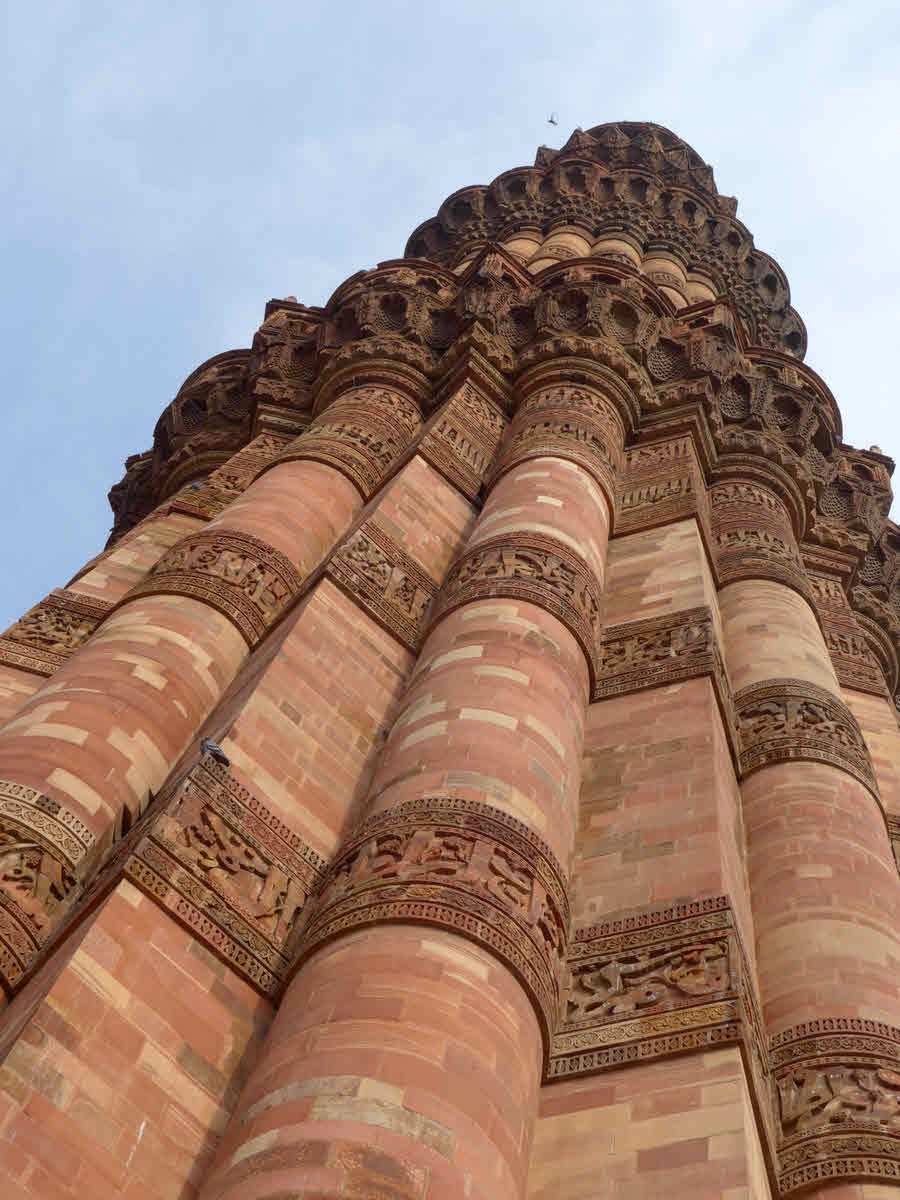

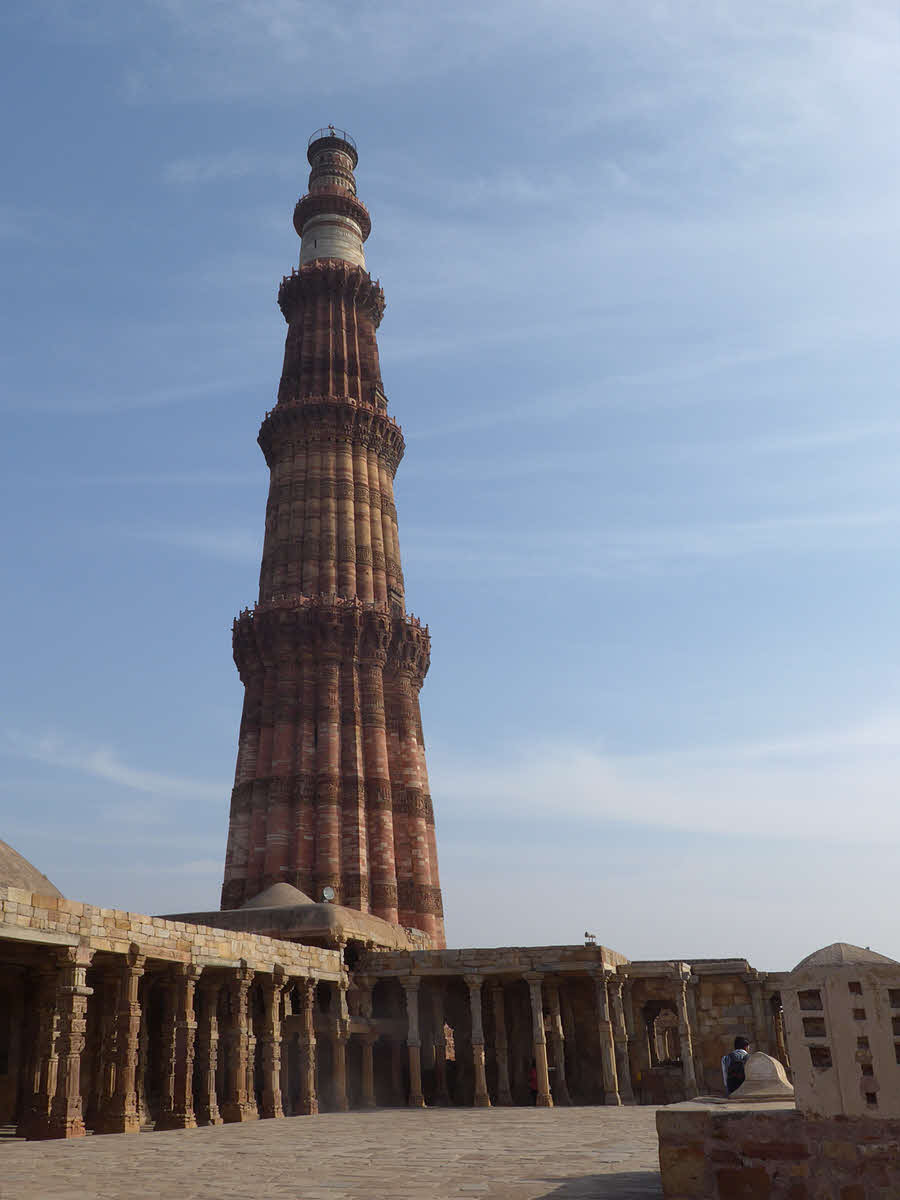
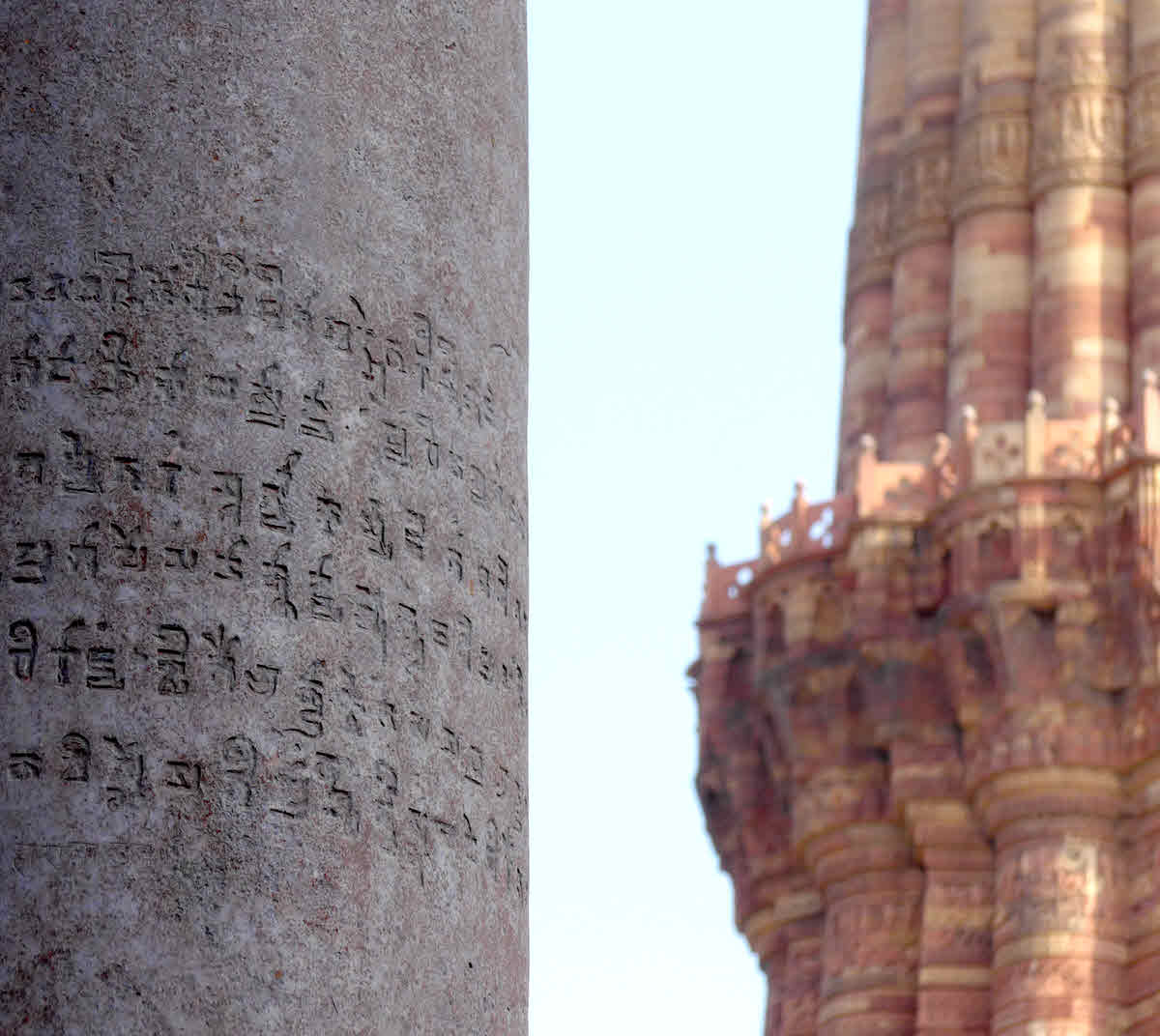
But the Qutb Minar was completed in 1368. I think we can forgive it the "missing" 28 meters, which would make it, even today, the tallest in India? I spend a frustrating 15 minutes on the web trying to learn more about the 100m minaret supposedly in Anandpur Sahib. Eventually, I decided to settle for the following from the Guiness World Records page: "Among minarets of earlier centuries the tallest is the Qutb Minar". (There is a modern minaret in Casablanca, at 200m. (And I failed to do adequate homework, didn't know it was there, and failed to see when I was in Casablanca!))
Synchronicity? A few hours after I wrote that, I came across...
"The traveler sees what he sees; the tripper [tourist] sees what he has come to see." - G.K. Chesterton (1874-1936)
I hope I am "a tripper"... it is certainly more fun and rewarding, when you put in the work. And, however some may disparage it, you can do a lot worse than Wikipedia, for digging out information on things you shouldn't miss on upcoming travels.
But the Qutb Minar is fabulous... but not as fabulous as the Qutab Complex's other claim to fame: The Iron Pillar (-WP-). Almost 24 feet long. Weighs more than 6 tons. Manufactured by the forge welding of pieces of wrought iron. Now.. don't let eye-glaze set in. Think about that... how would you, in a pre-industrial era, handle 6 tons of iron, let alone get bits hot enough that you could forge weld new bits to it?
And it is exquiste, with some very delicate inscriptions.
And it has been standing around in all winds, weathers for about a thousand years... and hasn't rusted. I could say more, but if you don't "get it" yet, maybe I should move on? Do think about it, if you aren't yet saying "Wow".
The day's final bit of "culture" was a up-close and personal experience with an Indian wedding celebration... just over the wall from my hotel room in Bhopal, after a long day of travel. Very loud! (125 feet away, as measured with Google maps... seemed closer!) But it wound down quite soon after we arrived, and all was quiet by the time we wanted to go to bed. Parts of India may be crowded, but people are considerate of one another. Work together to make things as good as they can be... even in traffic which would lead to bloodshed in the US.
A long day of driving... but with some fascinating respite in the midst of it, in the form of the Bhimbetka Rock Shelters (the link is to a Wikipedia page)... a UNESCO World Heritage site, where there is hominid archaeology 300,000 years old, and "cave" paintings from 30,000 years ago.
To put those datings in perspective: Homo sapiens only began to exhibit full behavioral modernity around 50,000 years ago. (Wikipedia))
The region was at one time known as "Gondwana". That name is also applied to one of the two "super-continents" which were all the earth had 200 million years ago. I guess that the geologist concerned thought of this region as old?
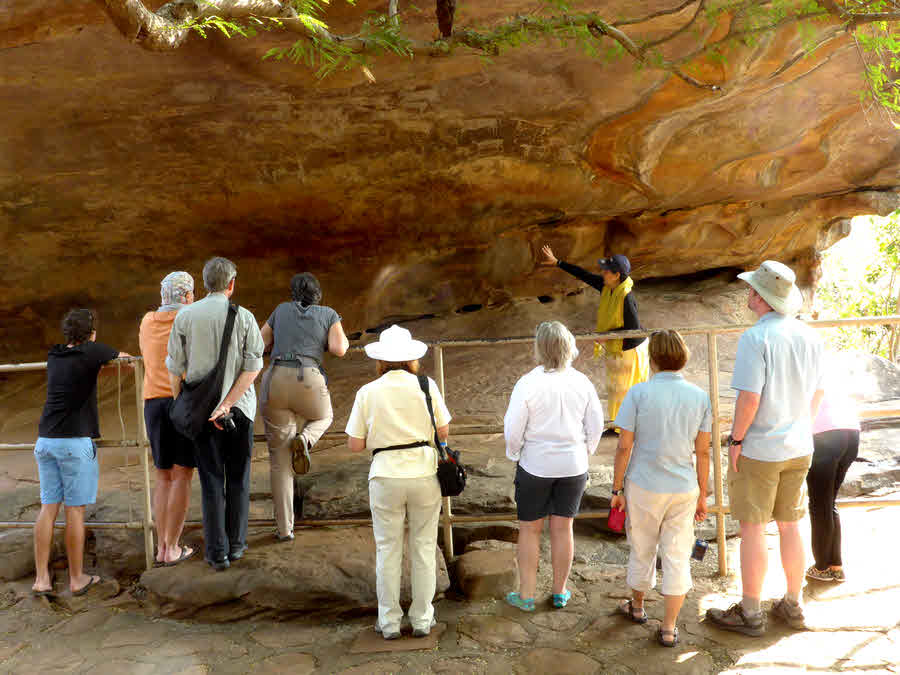
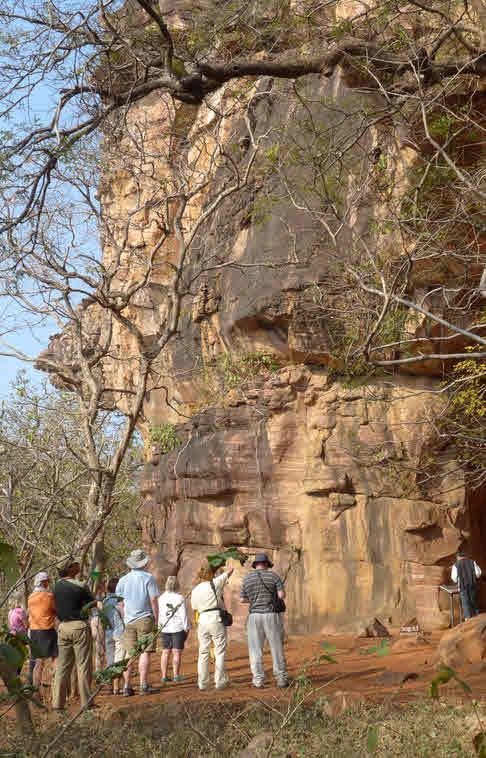
-
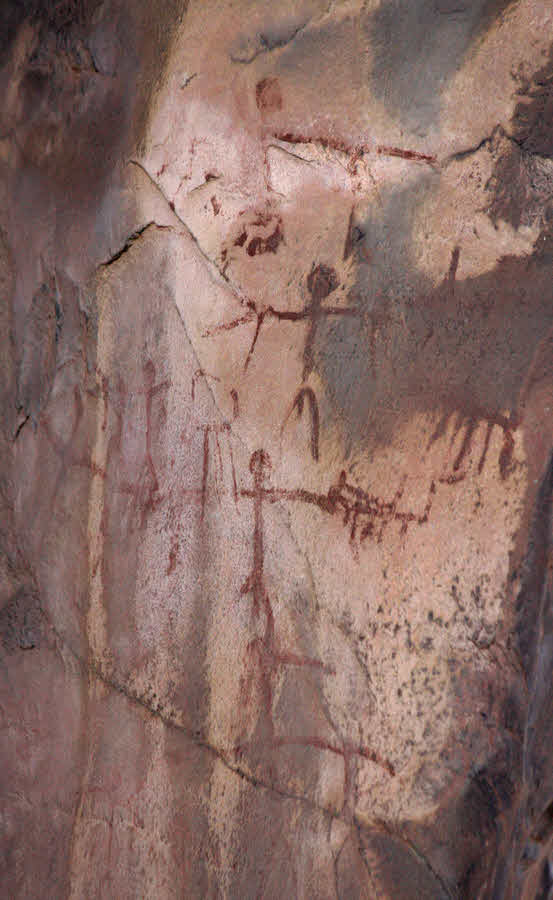
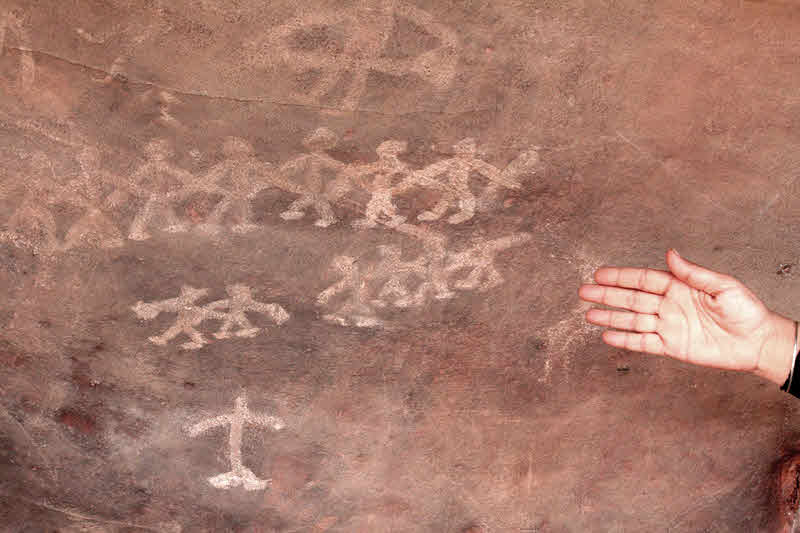
Nine thousand year old paintings on rocks, at the shelters at Bhimbetka (Wikipedia entry). (Both 9,000 years old, by carbon dating. Some were another 1,000 years older, but my photos of them weren't good.) The image on the right said to show people dancing.
We had an excellent quide here (and elsewhere.) If you are planning a trip to Bimbetka, consider contacting Rekha at rekha0863@gmail.com
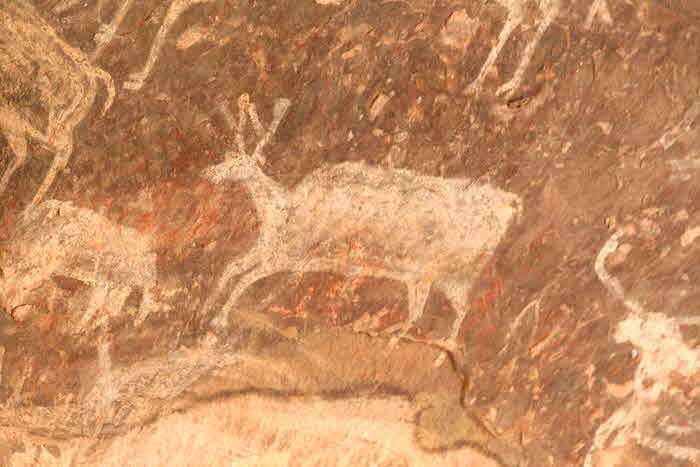
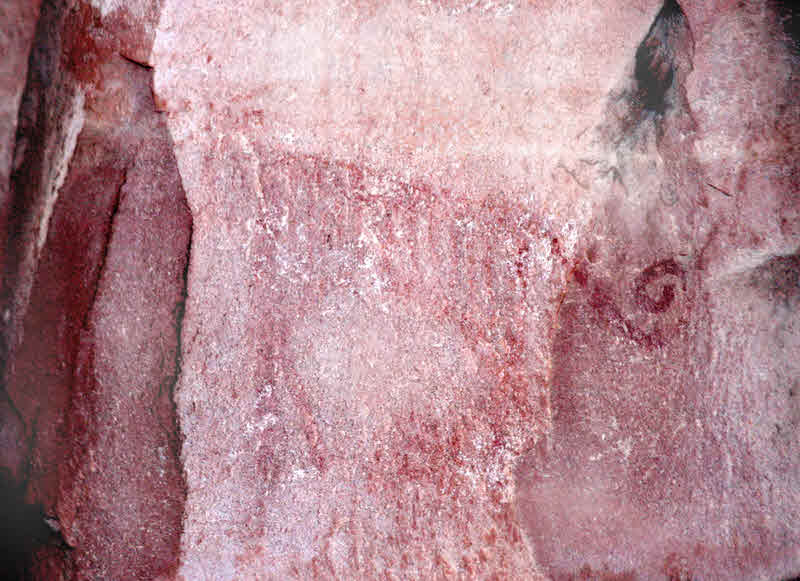
On left- more modern drawing... more representational, not "stick figure", of deer. About 4" high in real life. On right: A rather faded... and fading further, sadly... image of the beast we came to see: tiger. 3,000 years old. About 5" high. (Somewhat enhanced by photo manipulation software to help you see it. Tail at right, head largely gone.)
The "empty" days were far from empty... but there are things I still have to add, and days when we did LOTS... but not, necessarily, in the way of encountering culture.
Encountered this generator set just outside Pachmarhi. I wonder if Forsyth used it!? A friend is passionate about generators, so, Aaron, "This one's for you"!
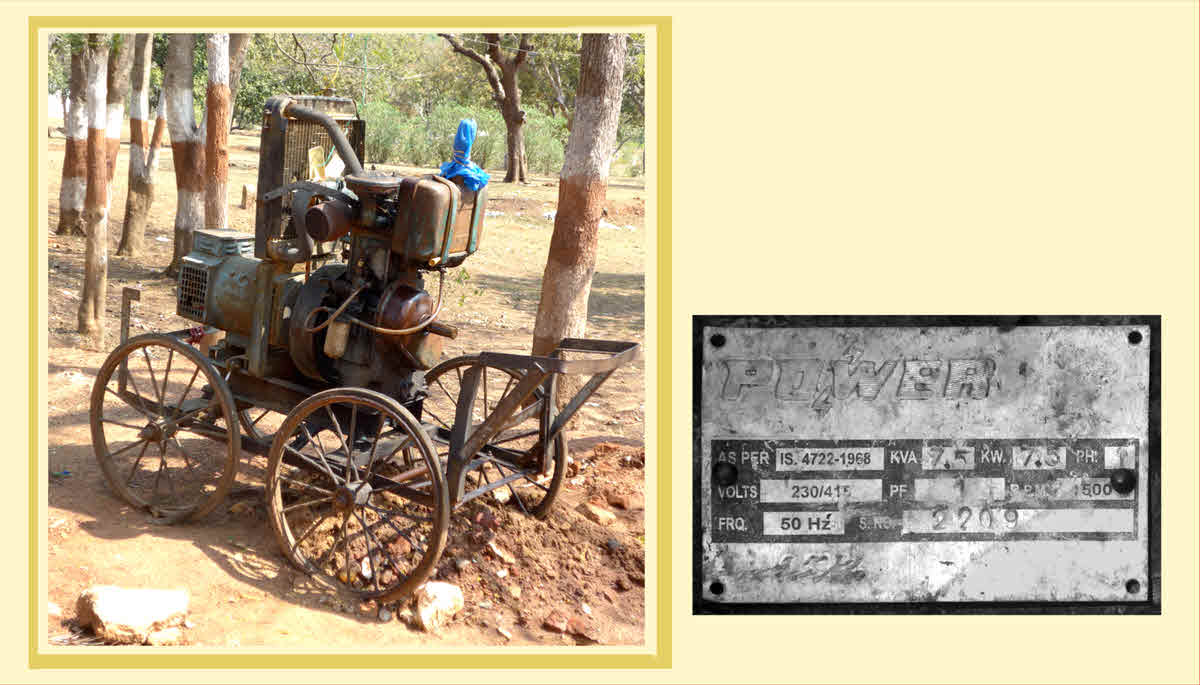
We traveled (in first class, thankfully!) on an "ordinary" Indian Railways train... Pipariya to Jabalpur. About 105 miles. I am not being frivolous when I say it was a marvelous experience. The Indians are justly proud of their busy and extensive rail network bequeathed to them from the British empire builders. Just one of several areas of basic civil infrastructure for "the common man" that is remarkably well maintained for a country with many poor people, extensive rural populations. Water towers and roads are another area of success. Signs at Pipariya train station. A rail journey is not to be missed, if you come close to a chance of trying it. (You can, for instance, travel from Delhi to Agra for the Taj Mahal by rail. But first class probably wise. A railway journey in India is just as much a "cultural" experience as, say, Humayun's tomb.
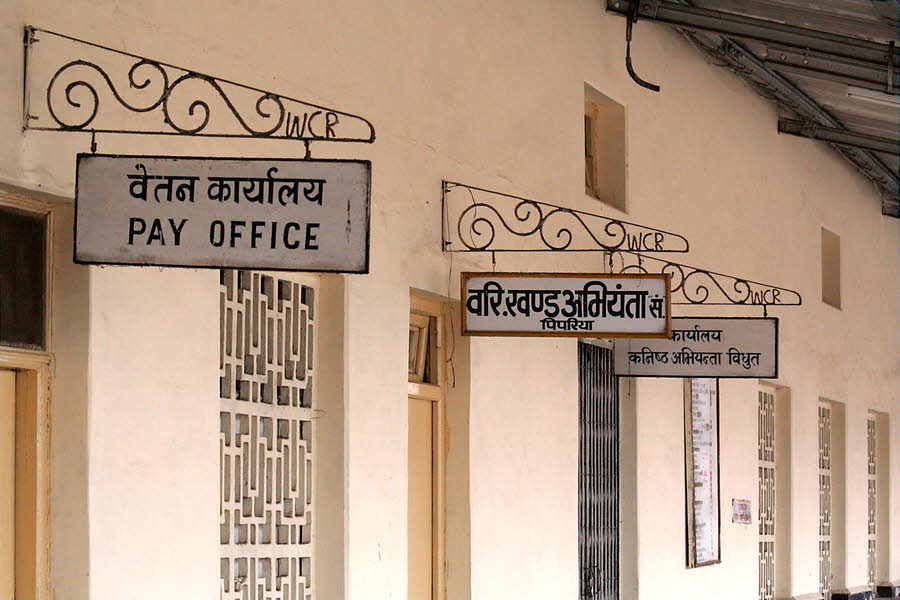
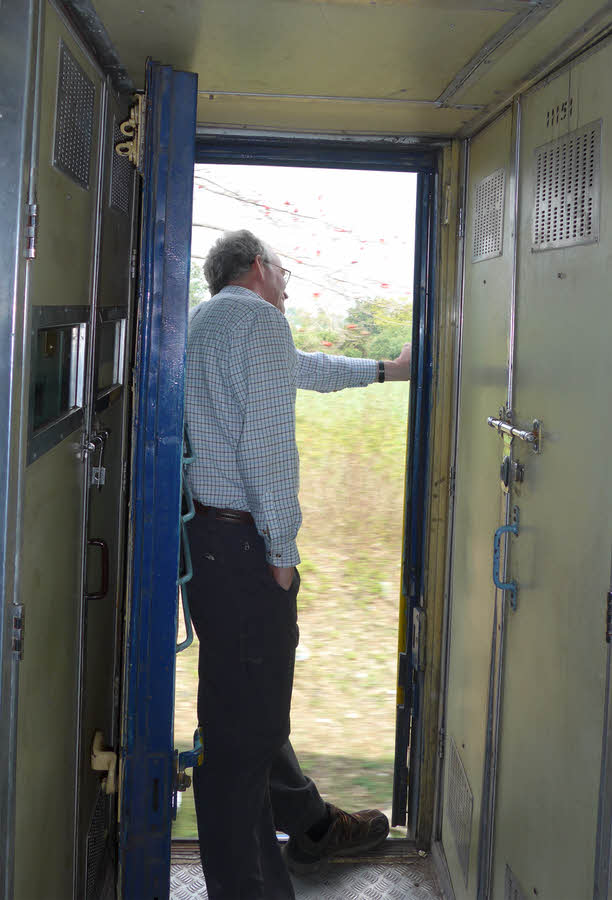
Car wasn't stuffy, but a bit of breeze once in a while is nice, and the view is better from the doorway.
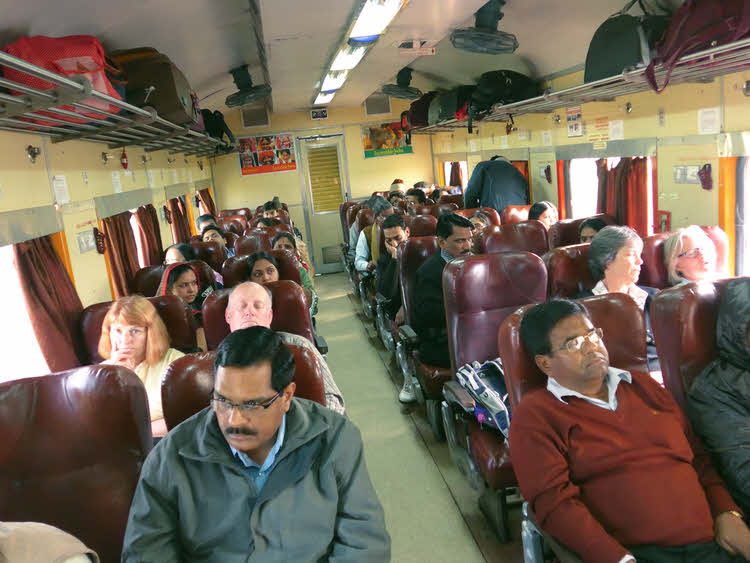
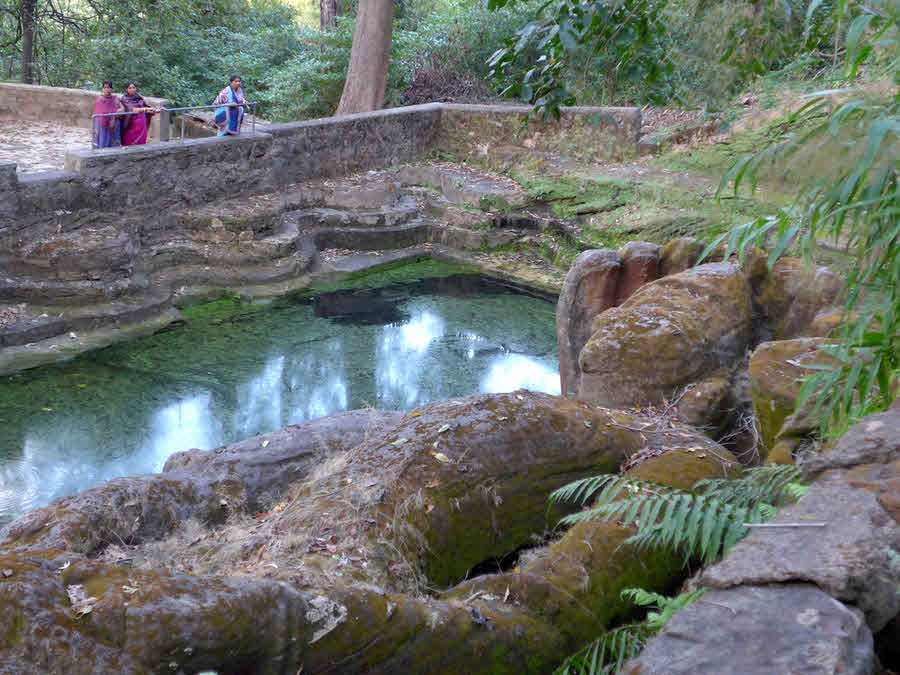
While driving round, and round and round Bandhavgarh, seeking alarm calls from the tiger food there, in hopes of being led to a tiger, we took a few breaks to enjoy other aspects of the reserve. A fair way up the flanks of the main hill, was a reclining Lord Vishnu, one of the Hindu trinity, and the god of wealth and well being. (The familiar Krishna and Rama are two of Vishnus ten avatars.) The site had a plaque headed "Sheshshaiya". A Google search suggests that "Shesh Shaiya" is the name for this particular representation of Lord Vishnu. It further states that the god is reclining on "the seven-hooded serpent Sheshnaag- the king of serpents." I think I'll remain agnositic... or at least subscribe to an uncomplicated religion.
Carved from a single block of sandstone, I presume out of the native rock, on site. Is positioned above a large water cistern. A spring rises here.
The statue is in the foreground of the photo, not quite as huge as the image might suggest. A sign at the site says 35 ft, an online reference says 65 ft. Certainly at least 35 ft, as I remember it.
Visit Khajuraho Temples Complex (Wikipedia link) en route.
UNESCO World Heritage site. Hindu and Jain temples... most from around AD 1000. The one on the left, however, is more modern, built around 1800. It was commissioned by a ruler who wanted to tell everyone that he believed in religious tolerance. The domes, from left to right, are Hindu, Buddhist, and Islamic.
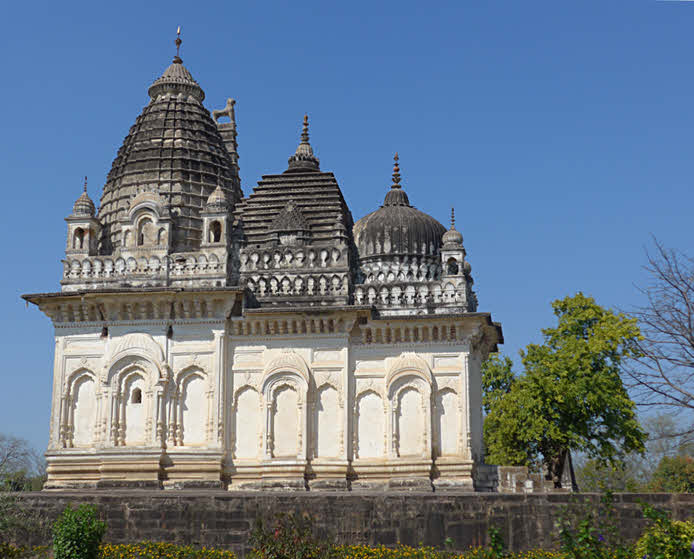
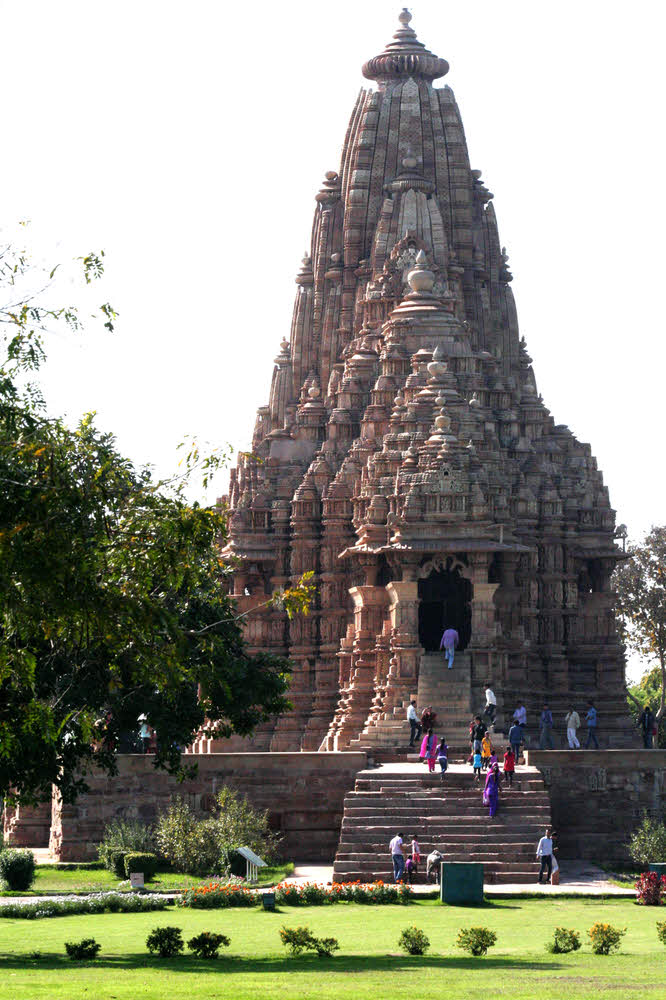
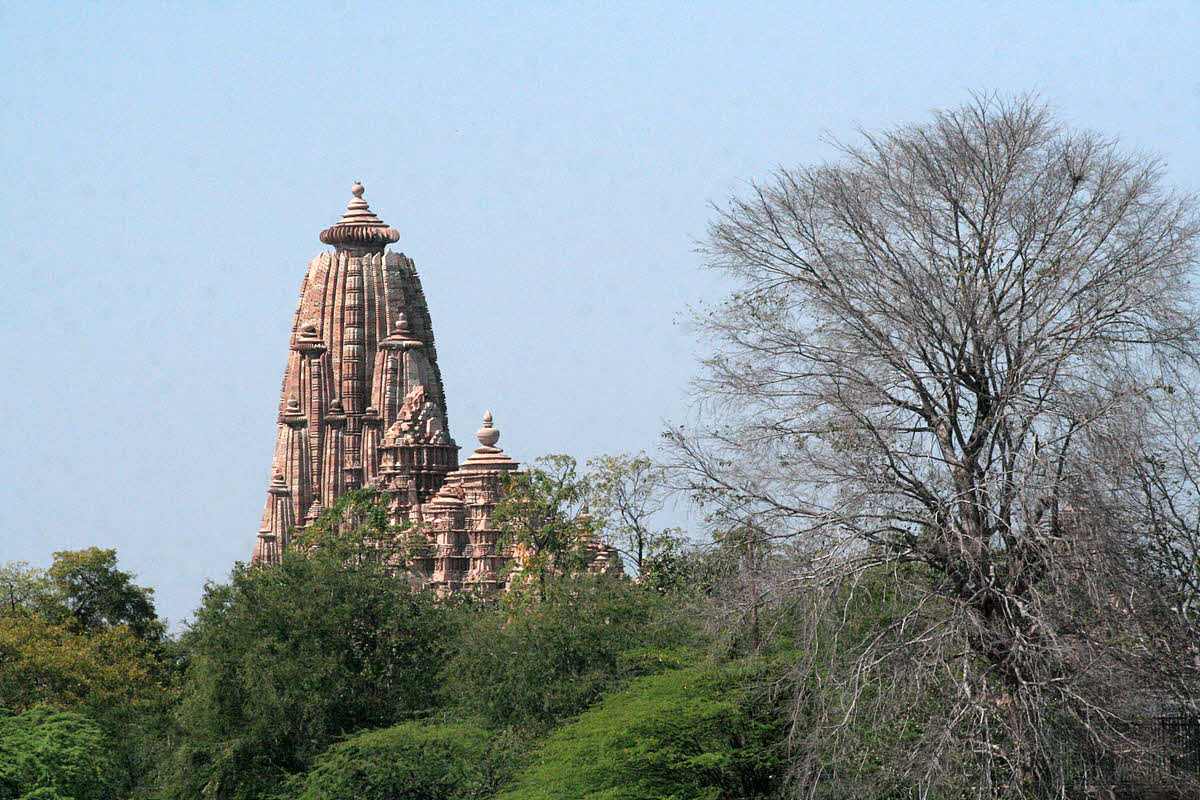
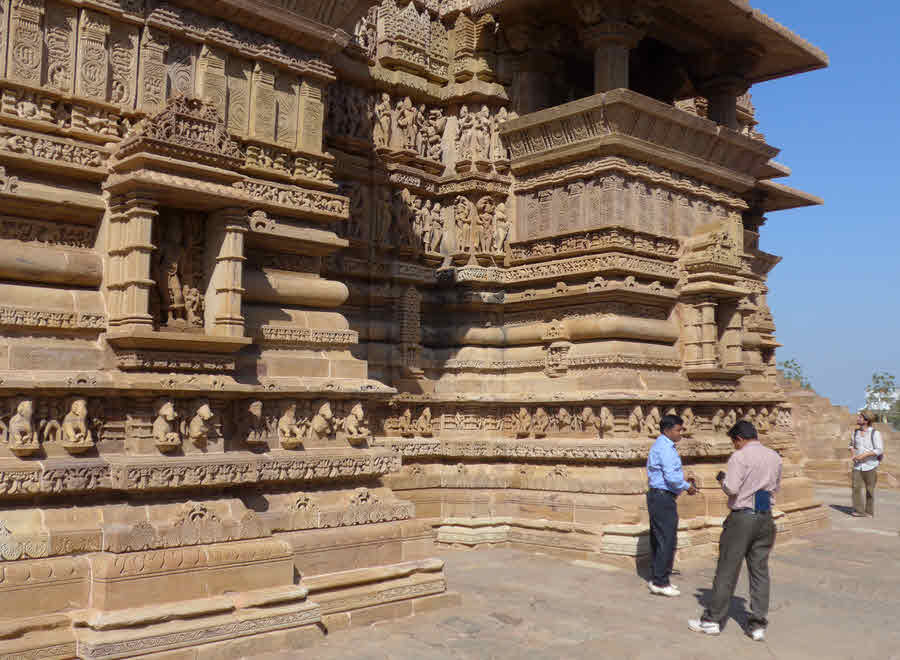
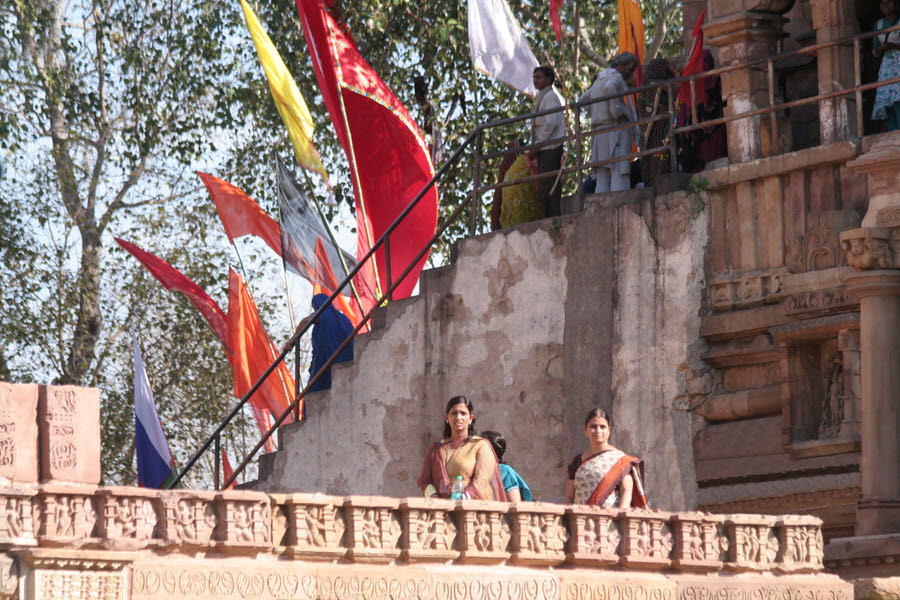
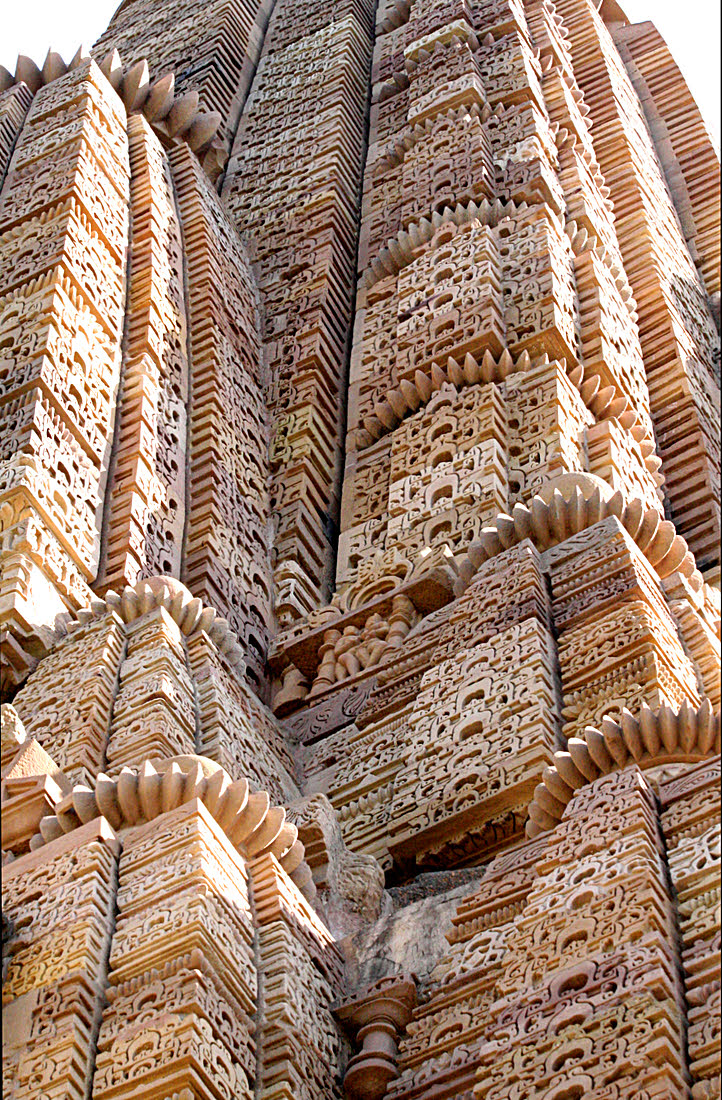
(Image above: Jigsaw puzzle, do you think?)
Train to Shimla. More to be said, photos to be added!
The famed "Hill railway to Shimla" (Wikipedia link). Narrow gauge.
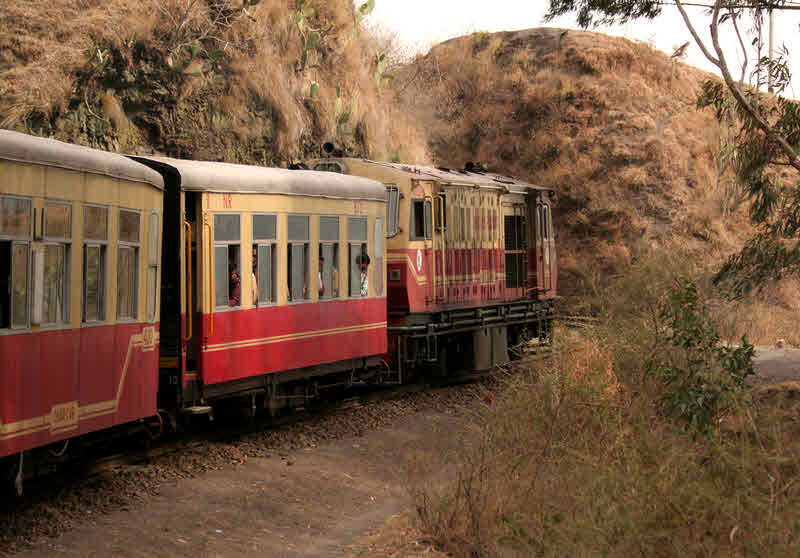
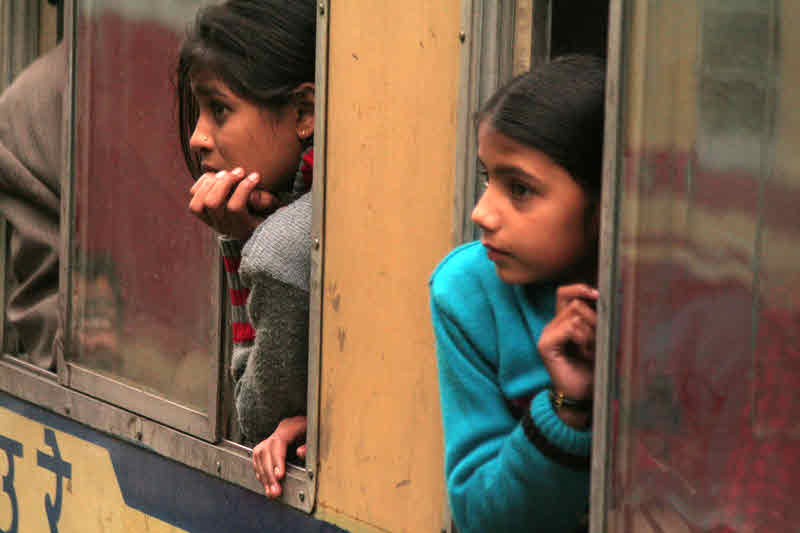
On left: Famous narrow gauge train to Shimla/ Simla. My great-uncle, and Jean Farwell (no one most readers will know... but some will), and her parents, would have taken it. Also Rudyard Kipling.
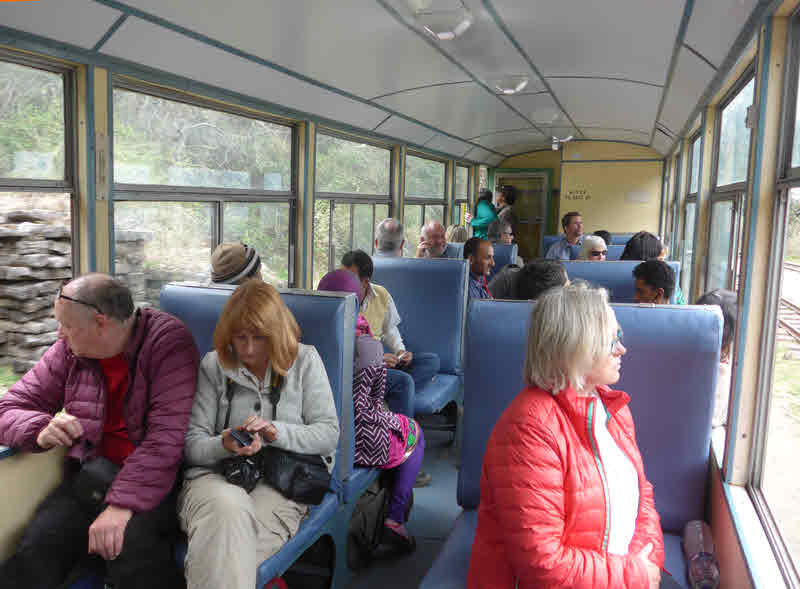
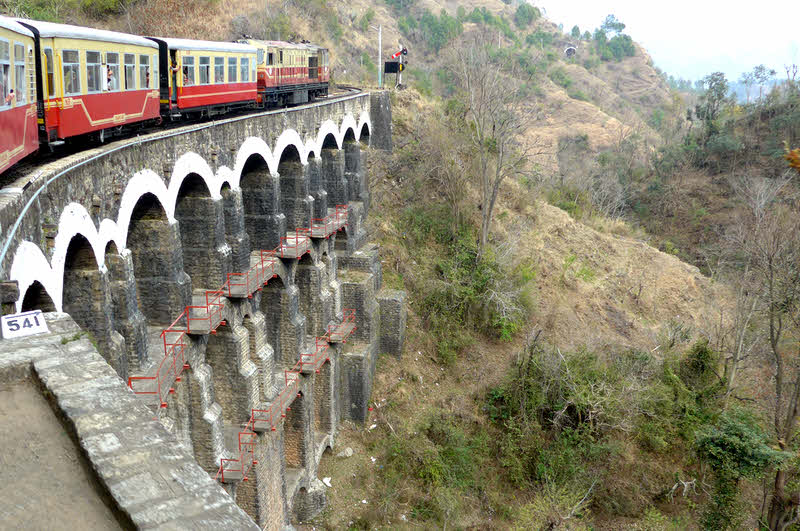
On left: Not a lot of spots like this on the train ride up to Shimla. No one complained.
And we passed... rapidly... through the edge of Shimla... a "cultural" entity in its own right. Visited it properly later.
(Visit Shimla)
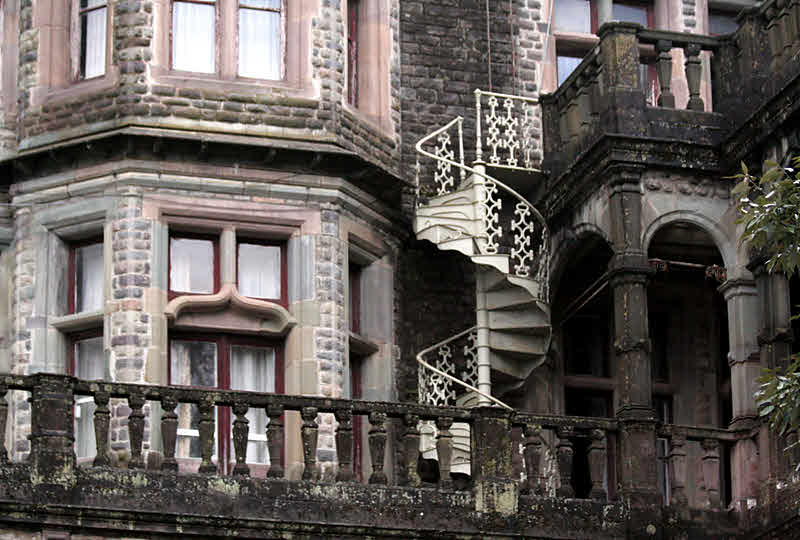
We started with a visit to what was the Viceregal Palace... from here, for many years, for a good chunk of the year, a good portion of the world was ruled. (If you haven't thought about the meaning of "Viceroy" until now, do it. "Roy": King (or Queen, even if that ought to be regina); "vice", alternate, as in "Vice President"... the representative of the King (or Queen), taking care of this (rather large... included Pakistan, Burma, etc... part of the empire.)
I was amused by a personal matter: The palace was built at almost exactly the same time as my great-grandfather was building his English home in Kent, and the styles reflect the fact. His house was smaller.

Not a rare bird; not a great photo... forgive my self indulgence. I just find kites too gorgeous to leave them out entirely, just because I did a poor job of photographing them. Also, as soon as I see one, it tells me I'm not in Kansas any more, and triggers memories of sundry marvelous trips, in particular Hong Kong, which is, I think where I first saw them. Took this at the Viceregal Palace, is why it is here.
Still the 11th, moving on, to "The Mall", where so much happened in the lives of the colonial rulers. See Kipling's "Plain Tales from the Hills". You can read it online, or download various formats. It is an anthology... try the first three, anyway? (It certainly includes very readable stories of life in Shimla, but I'm confused... I know he was familiar with the Satpura region, and believe that it is this which he would have called "the hills". The English migrated between the two. Jungle Book is set in the Satpura area.)
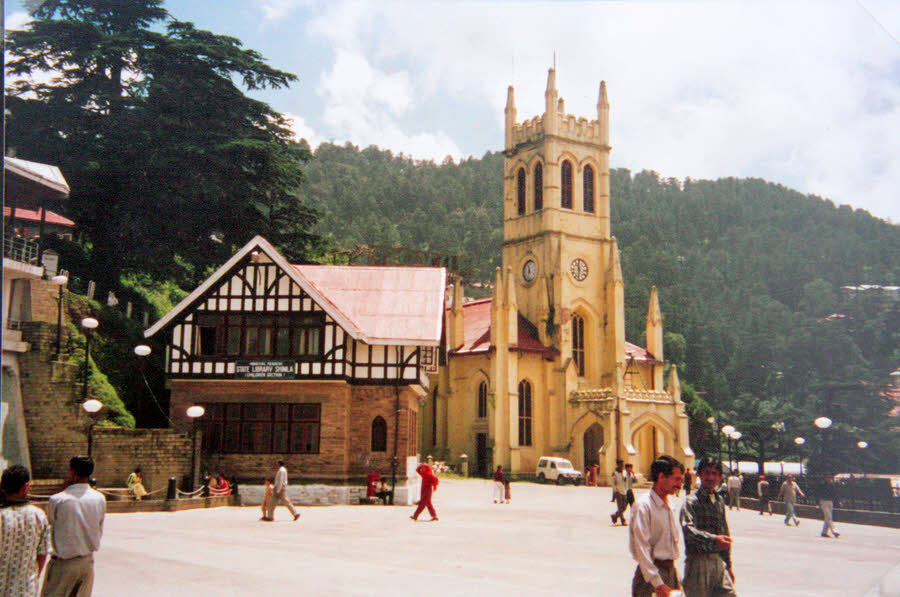
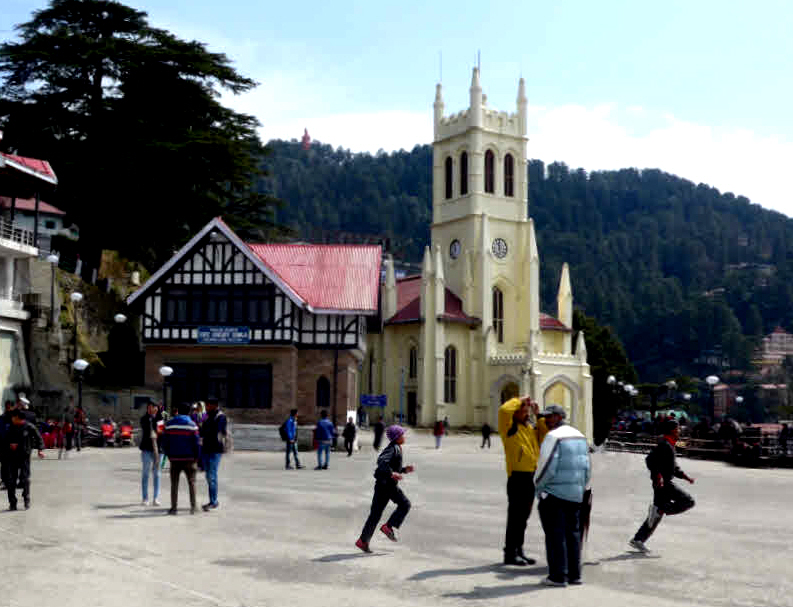
Fool? Moi? I spent about 3 hours creating the right hand image above. The plaza at Shimla was busy when I tried to retake a picture taken by a friend around 2000. My photo (on right) is a composite of multiple photos, to "get rid" of the crowds. (To add insult to injury... part of the time I spent was "building" a bigger image, one which I subsequently cropped down. Sigh.)
The left-hand image is the same view, taken a ni about the year 2000 by a friend.
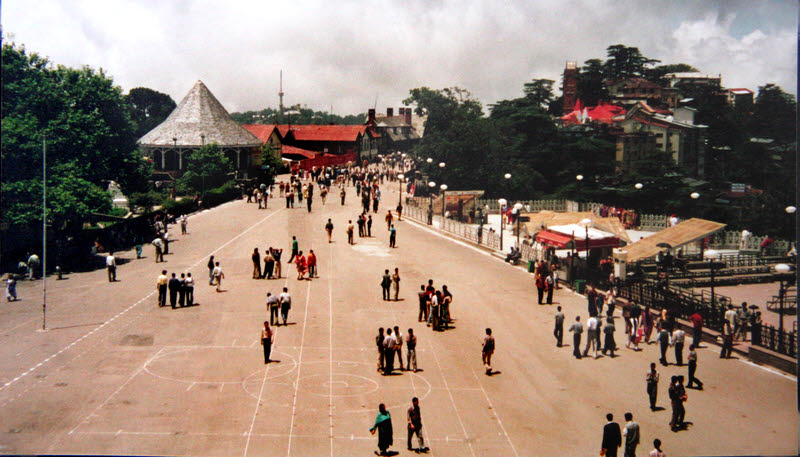
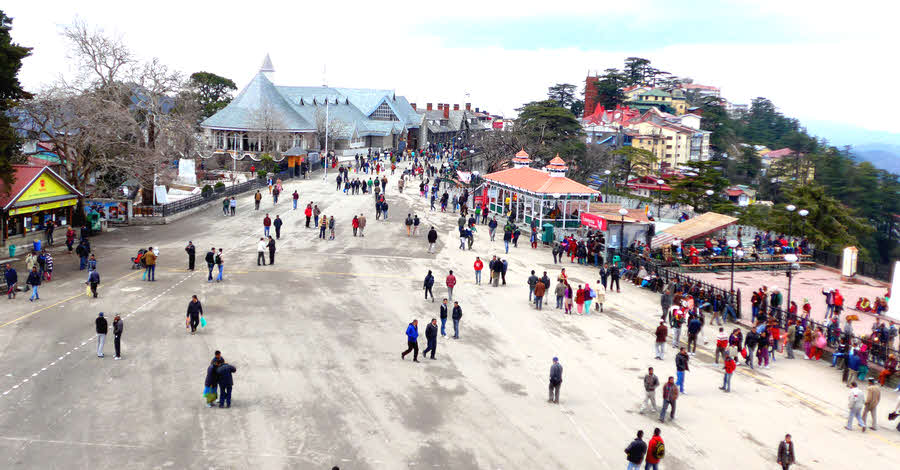
Okay... let's see how this goes. Started the above pair at 8:35. Left is from about 2000, right is March 2014.
The extended gray roof at the left is great news... the old Gaiety Theatre, nearly lost, saved, and now under long term support and care... and still "alive" as a theatre, hurrah! Rudyard Kipling both wrote plays for the Gaiety, and trod the boards.
Ha!... on to other things now, 9:05. Sigh.
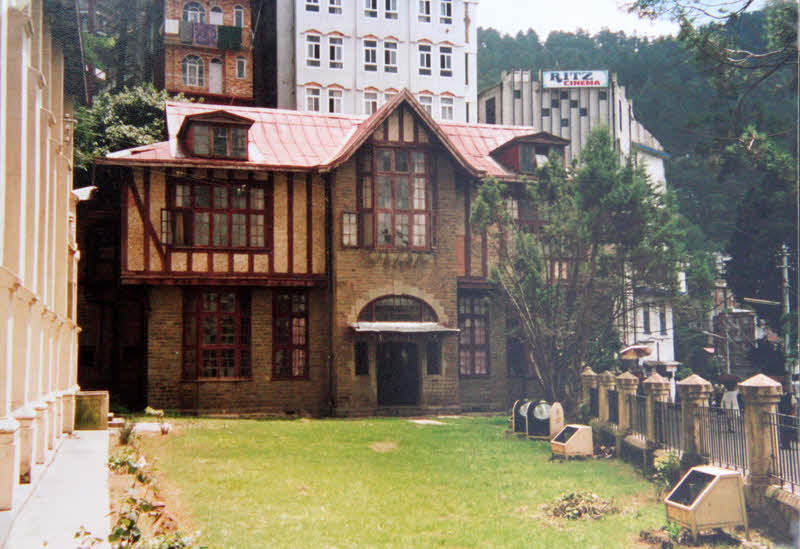
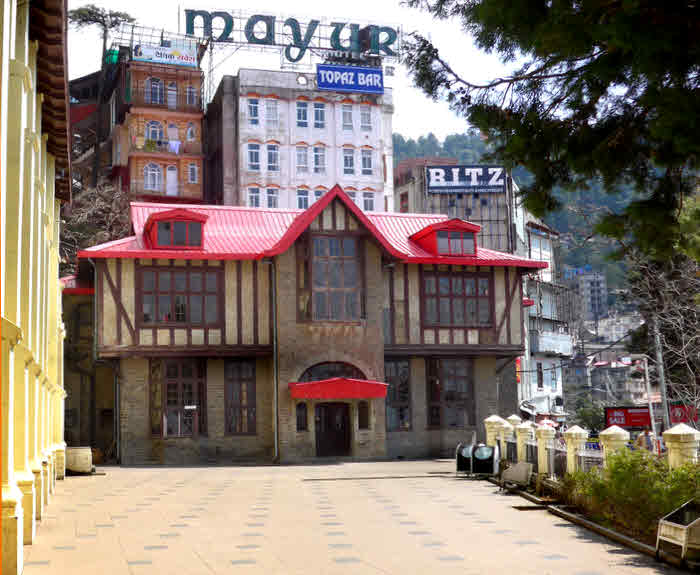
Another "then and now" (About 2000, and March 2013).... In Shimla, beside church at east end of mall. I suppose with the weather and tourists, you can't begrudge "them" for a path across the grass... but a "sea" of concrete? And is it really better without the tree? Progress. Bah.
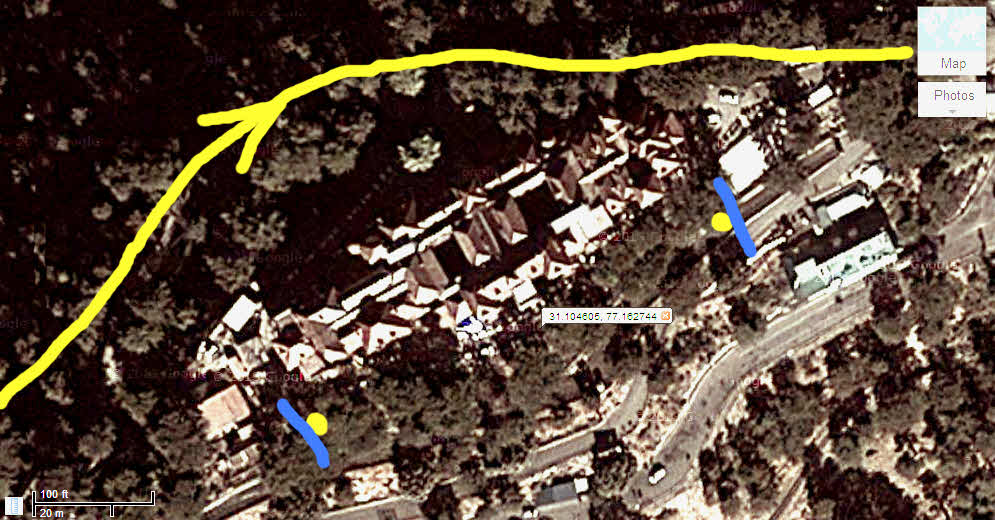
In the aerial above, you can get some hint of the scale of what was once a remarkable building. 120m long, from end to end. ("Ends" marked by short blue lines with yellow dots.) (Put "N31.104605, E77.162744" into maps.google.com, if you want to call up the current image.)
Wikimapia.org put me on the right track, identified it as "Gorton Castle". Google did the rest.
Had we visited Shimla only 8 weeks earlier, I could have seen this building in its glory. But there was a terrible fire. The image comes from before the tragedy.
The "Castle" is on the crest of the east/ west ridge Shimla is on. The yellow line marks a road we walked along, getting from where the cars could drop us to the western end of "the mall." It is quite a bit below the building. Looking up though the trees, and seeing the remains of the building against the sky... for ages, and ages, and ages was not a happy experience. You just knew that an "you'll never see its like again" building had died. I wonder how many rooms it had?
The Hindustani Times did an interesting story about the fire in Gorton Castle, with much on the building's history. Among other things, it says "This was the Government of India Secretariat Building from where the affairs of this vast country were administered during the summer months in the colonial times."
It did say in that article that only two floors (of five) of the building burned. But the roof was gone from end to end. From the poor glimpses I had of the remains of the building, it is hard to hope that it will be rebuilt in its former glory.
The building was in government hands. (Office of the Accountant General of Himachal Pradesh.) Firefighting on the site would have been extremely difficult, because of the drop-off behind, and the poor access at the front. Had reasonable precautions been taken in matters of fire safety? Hard to understand how it burned from end to end... along 120 meters. It had had major work done on it... were no sprinklers installed? Firedoors to prevent horizontal spread? An old building is often a disaster waiting to happen... but there are things you can do, and the article I mentioned said that at its core, it should have been fire resistant. (It wasn't timber to its core.)
Call me a sentimental old fool... the loss of this magnificent building breaks my heart. The charred remnants against the sky were terrible to behold.
Departed India from, quite sensibly, an airport hotel. Not a lot of "culture" involved... but some very welcome convenience! And we missed the "cultural" experience of more time in Delhi's traffic. Charming in its way. But. Umm.
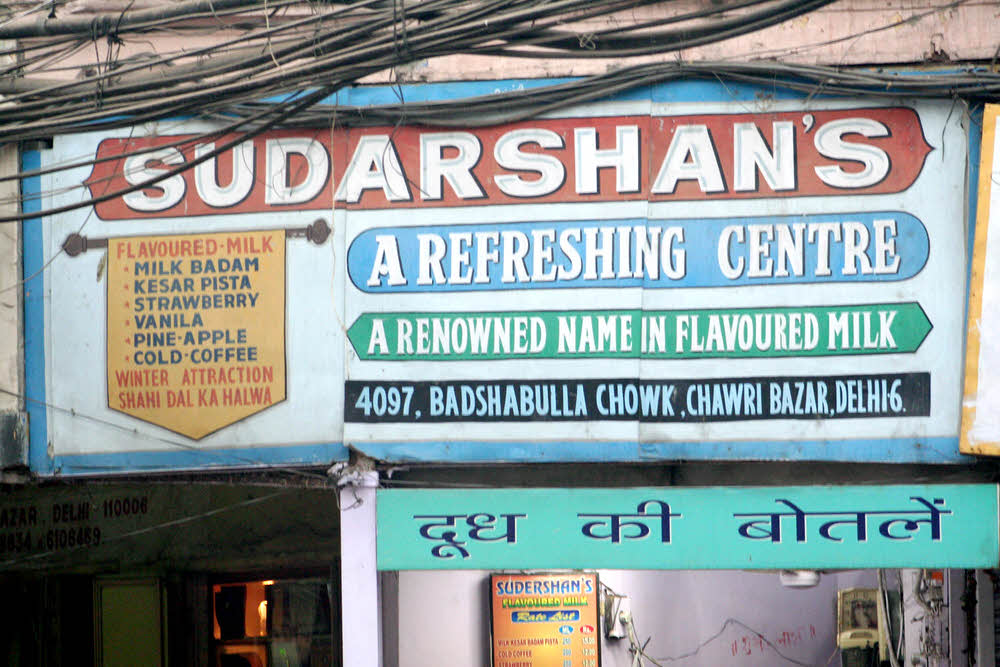
This photo is from my 2007 trip to India. I was warned then that the country was at the end of an era... the era of hand painted signs on shops. They were everywhere. The nasty, modern, sun-distorted colors, not "organic", just "stuck on" computer generated signs had not yet taken over. 2014... almost none of the charming, nice, old signs left. Progress. Bah. (The "creative" wiring of the country's electricity supply infrastructure, merely hinted at here, was still alive and well.)
At least, the marvelous extravageant personal decoration of vehicles continues. I started a series of photos of the signage on tuk-tuks alone, but didn't get far enough with it.
Speaking of "then and now", the Hillman Cambridge, common, mostly as taxis, in Delhi traffic in 2007, seems, mostly, to have gone the way of hand painted signs. I was hoping to see a Tata Nano, but failed. (Did see many Tata heavy lorries, at least. And some people gave good reports of the Nano, although the verdict wasn't unanimous, sadly. (Some people support a football team... I tend to "cheer for" companies in which I own stock. They do more for me... when I choose well... (and whose fault is it when I don't?) than any football team does for a fan.))
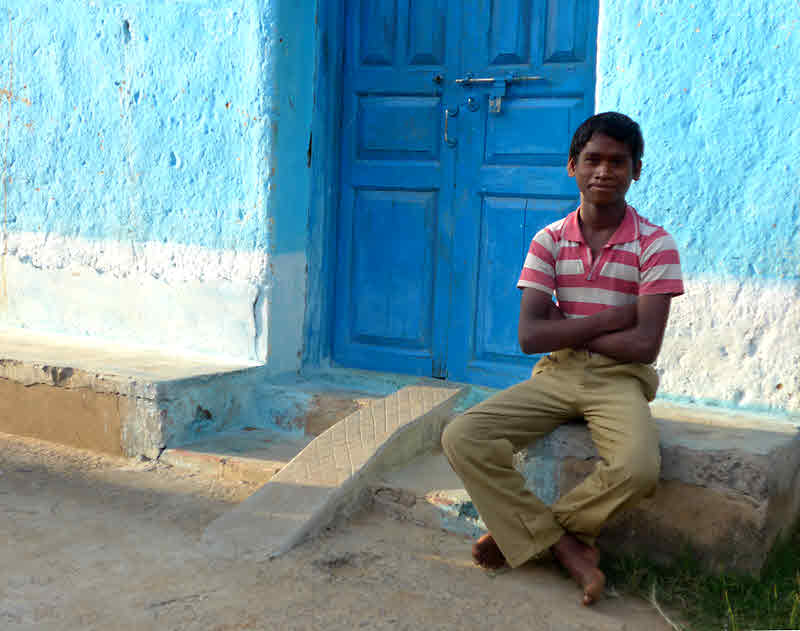
Back to my trip of 2014: The appreciation, and talent with, vivid colors remains alive and well. This in a small village near Bandhavgarh. I still maintain that in India, you can almost close your eyes, point your camera anywhere, click... and come up with an attactive picture more often than not.
That finishes my page about the cultural experiences afforded by the trip... though I suppose food is "culture", and we had marvelous experiences on that front too, and I've neglected it in this page. Don't "worry" about the (culturally) "empty" days... those days were quite full enough, in their own ways, which I hope is clear from other pages?
Want to look closely at some image? To zoom in on just bits of it? I explain how, and give some other browsing tips on the linked page.
If you came to this page by clicking on one of the links on the trip's main page, you can just close this tab to return there.
If you find yourself wanting to use a photo on this site, please see my page about using web-published material which is copyright TK Boyd. If you want to contact me, here's my eddress, or you can use the contact form. (Email best, as the contact form is often abused, and I don't read all messages arriving that way.) Corrections to bad information on the pages very welcome... don't be shy!
![]() Page has been tested for compliance with INDUSTRY (not MS-only) standards, using the free, publicly accessible validator at validator.w3.org. Mostly passes. There were two "unknown attributes" in Google Translate and Google+ button code. Sigh.
Page has been tested for compliance with INDUSTRY (not MS-only) standards, using the free, publicly accessible validator at validator.w3.org. Mostly passes. There were two "unknown attributes" in Google Translate and Google+ button code. Sigh.